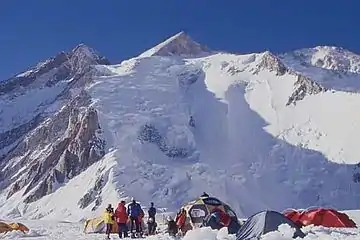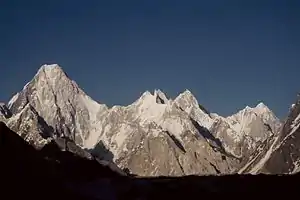Gasherbrum
Gasherbrum (Urdu: گاشر برم) is a remote group of peaks located at the northeastern end of the Baltoro Glacier in the Karakoram range of the Himalaya on the border of the Chinese- Xinjiang province and the Gilgit-Baltistan territory of Pakistan. The massif contains three of the world's 8,000 metre peaks (if Broad Peak is included). Although the word "Gasherbrum" is often claimed to mean "Shining Wall", presumably a reference to the highly visible face of Gasherbrum IV, it comes from "rgasha" (beautiful) + "brum" (mountain) in Balti, hence it actually means "beautiful mountain".





Geography
| Peak | metres | feet | Latitude (N) | Longitude (E) | Prominence (m) |
|---|---|---|---|---|---|
| Gasherbrum I | 8,080 | 26,509 | 35°43′27″ | 76°41′48″ | 2,155 |
| Broad Peak | 8,047 | 26,400 | 35°48′35″ | 76°34′06″ | 1,701 |
| Gasherbrum II | 8,035 | 26,362 | 35°45′27″ | 76°39′15″ | 1,523 |
| Gasherbrum III | 7,952 | 26,089 | 35°45′34″ | 76°38′31″ | 355 |
| Gasherbrum IV | 7,925 | 26,001 | 35°45′39″ | 76°37′00″ | 725 |
| Gasherbrum V | 7,147 | 23,448 | 35°43′45″ | 76°36′48″ | 654 |
| Gasherbrum VI | 6,979 | 22,897 | 35°42′30″ | 76°37′54″ | 520 |
| Gasherbrum VII | 6,955 | 22,818 | 39°44'19" | 76°36'0" | 165 |
| Gasherbrum Twins | 6,912 and 6,877 | 22,677 and 22,562 | 35°34'13" | 76°35'36" | 162 |
In 1856, Thomas George Montgomerie, a British Royal Engineers lieutenant and a member of the Great Trigonometric Survey of India, sighted a group of high peaks in the Karakoram from more than 200 km away. He named five of these peaks K1, K2, K3, K4 and K5, where the "K" denotes Karakoram. Today, K1 is known as Masherbrum, K3 as Gasherbrum IV, K4 as Gasherbrum II and K5 as Gasherbrum I. Only K2, the second highest mountain in the world, has retained Montgomerie's name. Broad Peak was thought to miss out on a K-number as it was hidden from Montgomerie's view by the Gasherbrum group.
Climbing history
| Mountain | altitude | first ascent | first winter ascent |
|---|---|---|---|
| Gasherbrum I | 8068 m | 1958 by Pete Schoening and A. J. Kauffman (USA) | 2012 by Adam Bielecki, Janusz Gołąb (Poland)[1] |
| Broad Peak (if included in group) | 8047 m | 1957 by Marcus Schmuck, Fritz Wintersteller, Kurt Diemberger and Hermann Buhl (Austria) | 2013 by Adam Bielecki, Artur Małek, Maciej Berbeka, Tomasz Kowalski (Poland) |
| Gasherbrum II | 8035 m | 1956 by Fritz Moravec, S. Larch, H. Willenpart (Austria) | 2011 by Simone Moro (Italy), Denis Urubko (Kazakhstan), Cory Richards (United States) |
| Gasherbrum III | 7952 m | 1975 by Wanda Rutkiewicz, A. Chadwick-Onyszkiewicz, Janusz Onyszkiewicz and K. Zdzitowiecki (Poland) | Unclimbed in winter |
| Gasherbrum IV | 7925 m | 1958 by Walter Bonatti and Carlo Mauri (Italy) | Unclimbed in winter |
| Gasherbrum V | 7147 m | 2014 by S. Nakjong and A. Chi Young (Korea) | Unclimbed in winter |
| Gasherbrum VI | 7001 m | Unclimbed, attempted 1998 by a French group (two dead) and a Danish group (Bo Belvedere Christensen, Mads Granlien and Jan Mathorne reaching 6200 m) | Unclimbed in winter |
| Gasherbrum VII | 6755 m | 2019 by Cala Cimenti (Italy)[2] | Unclimbed in winter |
| Gasherbrum Twins | Unclimbed | Unclimbed in winter |
See also
- Concordia, Pakistan
- Eight-thousander
- List of highest mountains
- List of mountains in Pakistan
Sources
- H. Adams Carter, "Balti Place Names in the Karakoram", American Alpine Journal 49 (1975), p. 53.
- Mount Qogori (K2) {scale 1:100,000}; edited and mapped by Mi Desheng (Lanzhou Institute of Glaciology and Geocryology), the Xi´an Cartographic Publishing House.
- Dreams of Tibet: the pundits